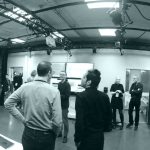During November and December 2018, I had the opportunity to spend 5 weeks as a visiting researcher at RITMO Centre for Interdisciplinary Studies in Rhythm, Time and Motion, an amazing centre of excellence recently inaugurated at the University of Oslo. In mid November, at the beginning of my stay, Luke Dahl and I presented modosc, our Max library for real time motion capture analysis to the attendees of the RITMO International Motion Capture Workshop. The library is the results of a collaboration between Luke and myself, and has been presented at various conferences in 2018, including NIME1 (paper) , and MOCO2 (paper).
While in Oslo, I had the chance to spend time in the RITMO Motion Capture lab and use their Delsys Trigno wireless EMG system synchronised with their Qualisys cameras. With that gear, I coded three new modosc objects for real-time processing of EMG signals synchronised with MoCap:
- mo.qtmSig: binds data from QTM analog boards to new signal addresses in the modosc namespace (under /modosc/signals);
- mo.zcr: calculates the zero crossing rate of a signal (useful feature for classification tasks);
- mo.tkeo: calculates the Teager-Kaiser energy-tracking operator (TKEO) of a signal (useful for onset detection and other things, to learn more check out Eivind Kvedalen’s PhD thesis: http://folk.uio.no/eivindkv/ek-thesis-2003-05-12-final-2.pdf). I got the idea of implementing this interesting feature from Geert Roks, a student at Goldsmiths University of London currently collaborating with Prof Atau Tanaka.
Here are some video tutorials to get you started with modosc.
